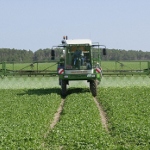You are here:
Plant protection products

Plant protection products protect plants or plant products from harmful organisms or diseases. They can also be used to regulate a plant’s growth. Plant protection products are classified into different groups according to their desired effect:
- Herbicides: used to control weeds
- Insecticides: used to control insects
- Fungicides: used to control fungal diseases
- Molluscicides: used to control snails
- Acaricides: used to control mites
- Rodenticides: used to control harmful rodents
- Growth regulators: used to control biological processes
Legal foundations and legally regulated procedures
The authorisation and use of plant protection products in Germany is regulated by the German Plant Protection Act (PflSchG) and related regulations, as well as European legislation, in particular Regulation (EC) No 1107/2009.
More detailed information on the legal foundations can be found here.
In Germany, plant protection products may only be used if they have been authorised for their intended purpose by the Federal Office of Consumer Protection and Food Safety (BVL). The BVL is the competent authority specified in the German Plant Protection Act. The Plant Protection Act also stipulates that BfR, the Julius Kühn-Institute (JKI) and the Federal Environment Agency (UBA) are to be involved in procedures related to plant protection products and specifies the competencies of these authorities.
Further information on the various legal procedures and the steps required for the authorisation of plant protection products in the EU can be found here.
Health risk assessment
BfR is responsible for the assessment of health risks posed by plant protection products. BfR’s health risk assessments cover the following areas:
- Toxicological assessments of plant protection products and the active substances and co-formulants they contain
- Derivation of limit values below which the exposure to a particular active substance is considered acceptable
- Suggestions for the classification and labelling of plant protection products and their active substances whenever they may be harmful to human health
- Determination of the amount of a plant protection product to which a particular group of people may be exposed (exposure)
- Proposal of maximum residue levels for active substances from plant protection products in food and feed
- Specification of safety measures for users when handling plant protection products and for people who are affected indirectly
- Assessment of analytical methods for monitoring residues of active substances from plant protection products
More in-depth information on the risk assessment process can be found here.
In its assessment, BfR takes into account all groups of people who may come into contact with plant protection products. This contact may occur as early as the application stage. These groups are:
- Users of plant protection products
- Workers (e.g. people carrying out follow-up work on a previously treated field)
- Residents who live next to a treated field
- Bystanders (e.g. people walking by the field while it is being treated)
- Consumers who may ingest residues of plant protection products through food or drinking water
The health risk assessments for the different groups of people ensure that plant protection products pose no unacceptable risks to human health.
Further information contain the pages on the assessment of consumer safety and residues of plant protection products and their safe application.
Beyond its specific risk assessments, BfR is also involved in the development of test guidelines and assessment concepts.
Monitoring of legal regulations
In Germany, the federal states are responsible for monitoring compliance with legal regulations. The use of products is monitored by the plant protection authorities of the federal states. The federal states also monitor plant protection products that are currently on the market. Monitoring offices in the individual federal states regularly verify compliance with the statutory maximum residue levels of active substances in food and feed. If exposure levels are too high, the affected food and feed are taken off the market.
For further information (documents, press releases) please have a look at our German webpage.
Information
(1)| Date | Title | Size |
|---|---|---|
|
26.03.2013 BfR Information
|
BfR concept for assessment of endocrine disrupting substances under different regulations |
51.8 KB
|
Background Information
(4)| Date | Title | Size |
|---|---|---|
|
16.05.2016 BfR Background Information No. 012/2016
|
WHO/FAO committee (JMPR) re-assesses glyphosate and confirms the BfR and EFSA conclusion that a carcinogenic risk is not to be expected |
52.7 KB
|
|
21.04.2016 BfR Background Information No. 010/2016
|
Epidemiological studies on glyphosate: No new findings for the European risk assessment |
43.2 KB
|
|
28.09.2015 BfR background information No. 034/2015
|
Assessment of the BfR concerning epidemiological studies on carcinogenic effects of glyphosate in the context of the EU active substance review |
37.2 KB
|
|
22.09.2015 BfR Background Information No. 033/2015
|
The BfR has made a comprehensive check of the epidemiological studies on glyphosate |
29.9 KB
|
Hilfsmittel zur Expositionsschätzung/ Tool for exposure estimation
(6)Tool for exposure estimation
(1)| Date | Title | Size |
|---|---|---|
|
02.02.2012 BfR model
|
BfR model for pesticide residue intake calculations (NVS II-Model incl. VELS-Model) |
656.5 KB
|
Opinion
(15)Infographic
(2)| Date | Title | Size |
|---|---|---|
|
21.09.2016 Infographic
|
Zonal authorisation procedure for plant protection products in the EU |
183.4 KB
|
|
14.06.2016 Infographic
|
EU Approval Process of Active Substances in Plant Protection Products |
244.2 KB
|
Conference report
(1)| Date | Title | Size |
|---|---|---|
|
18.06.2014 Conference report
|
European Conference on Safe Use of Plant Protection Products |
88.2 KB
|
